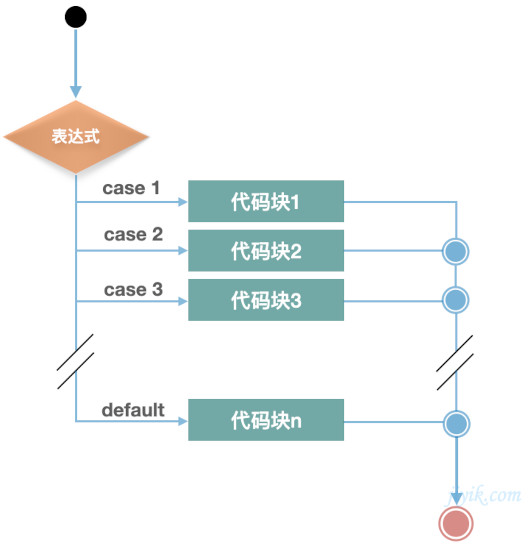扫码一下
查看教程更方便
switch 语句用于基于不同条件执行不同动作,每一个 case 分支都是唯一的,从上至下逐一测试,直到匹配为止。
switch 语句执行的过程从上至下,直到找到匹配项,匹配项后面也不需要再加 break。
switch 默认情况下 case 最后自带 break 语句,匹配成功后就不会执行其他 case,如果我们需要执行后面的 case,可以使用 fallthrough 。
Go 编程语言中 switch 语句的语法如下:
switch var1 {
case val1:
...
case val2:
...
default:
...
}
变量 var1 可以是任何类型,而 val1 和 val2 则可以是同类型的任意值。类型不被局限于常量或整数,但必须是相同的类型;或者最终结果为相同类型的表达式。
您可以同时测试多个可能符合条件的值,使用逗号分割它们,例如:case val1, val2, val3。
流程图:

package main
import "fmt"
func main() {
var grade string = "B"
var marks int = 90
switch marks {
case 90: grade = "A"
case 80: grade = "B"
case 50,60,70 : grade = "C"
default: grade = "D"
}
switch {
case grade == "A" :
fmt.Printf("Excellent!\n" )
case grade == "B", grade == "C" :
fmt.Printf("Well done\n" )
case grade == "D" :
fmt.Printf("You passed\n" )
case grade == "F":
fmt.Printf("Better try again\n" )
default:
fmt.Printf("Invalid grade\n" );
}
fmt.Printf("Your grade is %s\n", grade );
}
上述代码编译执行结果如下
Excellent!
Your grade is A
switch 语句还可以被用于 type-switch 来判断某个 interface 变量中实际存储的变量类型。
Type Switch 语法格式如下:
switch x.(type){
case type:
statement(s);
case type:
statement(s);
/* 你可以定义任意个数的case */
default: /* 可选 */
statement(s);
}
package main
import "fmt"
func main() {
var x interface{}
switch i := x.(type) {
case nil:
fmt.Printf("type of x :%T",i)
case int:
fmt.Printf("x is int")
case float64:
fmt.Printf("x is float64")
case func(int) float64:
fmt.Printf("x is func(int)")
case bool, string:
fmt.Printf("x is bool or string")
default:
fmt.Printf("don't know the type")
}
}
上述代码编译执行结果如下
type of x :<nil>
使用 fallthrough 会强制执行后面的 case 语句,fallthrough 不会判断下一条 case 的表达式结果是否为 true。
package main
import "fmt"
func main() {
switch {
case false:
fmt.Println("1、case 条件语句为 false")
fallthrough
case true:
fmt.Println("2、case 条件语句为 true")
fallthrough
case false:
fmt.Println("3、case 条件语句为 false")
fallthrough
case true:
fmt.Println("4、case 条件语句为 true")
case false:
fmt.Println("5、case 条件语句为 false")
fallthrough
default:
fmt.Println("6、默认 case")
}
}
以上代码执行结果为:
2、case 条件语句为 true
3、case 条件语句为 false
4、case 条件语句为 true
从以上代码输出的结果可以看出:switch 从第一个判断表达式为 true 的 case 开始执行,如果 case 带有 fallthrough,程序会继续执行下一条 case,且它不会去判断下一个 case 的表达式是否为 true。
